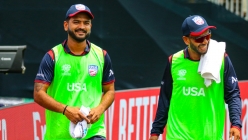Indian cricket has two eras BG and AG - A tribute to Sunil Gavaksar
2009 Jul 08 by DreamCricket
Sunil Gavaskar turns 60 on Friday and while it is an occasion to wish the master technician a very happy birthday it will also be relevant to remember his immeasurable contribution to Indian cricket. Simply put if the history of mankind is divided into two eras - BC and AD - Indian cricket can be divided into two eras - BG and AG.
Sunil Gavaskar turns 60 on Friday and while it is an occasion to wish the master technician a very happy birthday it will also be relevant to remember his immeasurable contribution to Indian cricket. Simply put if the history of mankind is divided into two eras - BC and AD - Indian cricket can be divided into two eras – BG and AG. The 39 years prior to 1971 when he burst upon the international scene so remarkably were generally marked by defeats, disasters and debacles and very few victorious moments. The 38 years since his advent have generally been marked by glorious triumphs, rare individual feats and greater respect for Indian cricket and cricketers in the international arena. Sure, there have been the low points but these have been comparatively few.
Today, 22 years after his retirement he is revered as the father figure of Indian cricket. He was the pioneer, the man who proved that fast bowlers could be hit and are not menaces against whom one flinched. He was a batsman who proved that it was possible to get 13 Test hundreds against the West Indies - including three double centuries. He proved that it was possible to break the 10,000 run barrier in Test cricket and to overtake Don Bradman's record tally of 29 hundreds. Most important, he inspired his teammates not to wince against fast bowling or falter against the turning ball. Thanks to him, many others learnt about the essential qualities of dedication and determination, technique and temperament, patience and perseverance, concentration and commitment. And soon the upward swing in India's fortunes was there for the cricketing world to watch and admire.
Before Gavaskar came on the scene, the chief image of Indian cricketers was that of `dull dogs' who took an inordinately long time to get their runs. They lacked the will to fight and were technically and temperamentally ill equipped. The history of Indian cricket was punctuated - all too frequently - by shameful reverses. On one infamous occasion at Leeds in 1952, India lost their first four wickets without a run on the board. In the same series, at Old Trafford, India became the first team in Test cricket to be bowled out twice in one day - and for totals of 58 and 82. In the next Test at the Oval, India lost the first five wickets for six runs. A few years later, India lost a Test to West Indies at Calcutta by an innings and 336 runs - the second biggest margin of defeat in Test cricket. In the period 1967-68, India lost seven Tests on the trot. In 1959 and 1962, India lost all five Tests of the rubber to England and West Indies.
It might not be exactly right in saying that one man changed this depressing scenario. But that would be close to the truth. Gavaskar's entry itself coincided with India's first-ever victory over West Indies, followed by a triumph in the series. Gavaskar was mainly responsible for this, scoring 774 runs with four hundreds, including a century and a double century in the final Test. His deeds inspired the greater triumph that followed in England the same year. And so the saga continued till 1987. And along the way, there were individual and team feats that none would have thought the Indian team and Indian cricketers were capable of. Scoring 400 plus to win a Test, running up totals of 600 plus more than once, making bowlers sweat it out for more than a day to earn a wicket. And inspired by the greater solidity in the batting, the bowlers have risen to the occasion and shaped numerous notable triumphs.
Before Gavaskar came on the scene, India had won only 15 of 117 Tests. In the next 129 Tests, till Gavaskar played his last game at Bangalore in 1987, India won 25. As regards losses, India in the period 1932-1970 suffered 49 defeats, while in the period 1971-1987 India lost 35 Test matches. Before 1971, India won five rubbers - three against New Zealand and one each against Pakistan and England. From 1971 to 1987, India won ten rubbers, four times against England, twice against West Indies and one each against Pakistan, Australia, Sri Lanka and New Zealand. Before 1971 India had won only one series abroad against a none-too-strong New Zealand side in 1967-68. After Gavaskar came on the scene India won rubbers in West Indies and England (twice). Notwithstanding some reverses in the post-1987 period - in itself a tribute to the great man - there is little doubt that Gavaskar's legacy endures. And today's champion Sachin Tendulkar would be the first to admit the inspirational role that Gavaskar has played and the exalted status SMG enjoys in the history of Indian cricket.
Though he also captained India in 47 Tests Gavaskar's chief image will be that of Indian cricket's most commanding personality, the country's greatest opening batsman and one of the world's best of all time. And I know that there are many, who despite the greatness of Tendulkar, still swear by Gavaskar as India's No 1 batsman of all time. After all, the pioneer, the man who shows the way, always has a special aura.




